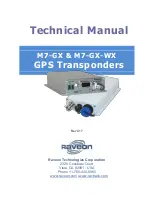
Chapter 10: Working with radar
79
4. When you have finished, click the
BACK
button.
FTC
You can use the Fast Time Constant (FTC) function to remove areas of
clutter at a distance from your boat. It should be used in conjunction with
the RAIN function to obtain the best results.
When the FTC function is turned up, only the leading edge of large (rain
clutter) echoes is shown, while the effect on smaller (boat) echoes is slight.
This means that you can also use the function on shorter ranges to distin-
guish between two very close echoes on the same bearing, which may
otherwise merge and appear as one echo.
With the FTC function set high, the receiver is made less sensitive, and
there is a reduction of background noise and fill-in reTurns from land and
large targets. You should therefore set the control to low (or Off) when its
use is not required.
Rain mode
Your radar can see echoes from rain and snow. These reTurns from storm
areas and rain squalls consist of countless small echoes that continuously
change size, intensity and position.
You should use the rain function to reduce large clutter masses from these
reTurns around your boat
Sea mode
The sea clutter control reduces the gain level in the area near your boat,
extending for 3 to 5 nm depending on the wave and sea conditions. This
reduces sea echoes to intermittent small dots, while small targets remain
visible. Gain levels further from your boat are unchanged.
The sea clutter control can be set to Auto-Harbor (default), Auto-Offshore,
or manual mode. In Auto-Off-shore mode, the radar optimizes its settings
to account for the effects of sea clutter. In harbors and close proximity to
land, different auto settings may be necessary to account for land clutter.
To avoid losing small targets, set the sea clutter control to Auto-Harbor
mode. If you set the sea control to manual mode, be sure you adjust the
settings to ensure that all close small targets are visible.
Gain mode
The gain control adjusts the level of the display of signals received from the
scanner; and is the equivalent to the volume control on a radio. The gain
control can be set in either Auto or Manual mode.
In auto mode, the radar self optimizes its settings. In harbors or close prox-
imity to land, different auto settings may be necessary to compensate for
the effects of land clutter.
In manual mode, you must adjust the settings to ensure that all close small
targets are visible, and you should check it every time you change the
range scale. On long range settings, the gain should be set to give a slight
speckle in the background of the radar picture. On shorter ranges, you may
want to reduce the gain slightly to reduce the speckle and improve target
definition. Do not set the gain too low, or you may miss small or weak
targets. The gain mode and its associated settings are retained each time
you turn the radar off.
Tune
You can use the tune control to fine-tune the receiver in the radar’s scanner
to yield maximum target reTurns on the display.
In Auto mode, the radar tunes itself automatically on all range scales. If
you decide to use manual fine-tuning, adjust it about 10 minutes after you
80
RayTech RNS V6.0 - Users Guide
have turned the radar on to allow the magnetron to warm up. The
optimum setting varies slightly for different display ranges, depending on
the pulse width used.
Note:
It is recommended that you leave the tune function in AUTO mode, to
ensure that the radar receiver is always tuned to receive the maximum signal.
10.6 Making targets clearer?
You can improve a target’s visibility using the Target function controls.
The functions are:
•
Int Rej.
•
Expansion.
•
Wakes.
•
Clear Wakes.
To use the targets controls:
1. Click on the soft key for the required function.
2. Click on the soft key for control options.
3. Adjust the settings as necessary.
4. When you have finished, click the
BACK
button.
Interference rejection
The interference rejection (Int rej) function reduces the interference caused
by radar equipped boats operating within range of each other.
Expansion
The target expansion function makes targets easier to see by expanding
them. The radar scanner type determines the range at which target expan-
sion is available. Target expansion overrides the normal pulse length,
thereby increasing the size of the target seen on the screen; however, this
is at the expense of range resolution.
Wakes
The wakes function enables you to see the direction and speed with which
targets are moving relative to your boat.
With wakes switched on, a target is displayed at the brightest level, while
its previous positions are retained at successively fainter levels on the
screen. You can select long, medium or short wakes, which retain informa-
tion from previous scans at a reduced video level.
10.7 Setting up the radar display
Range control enables the radar picture to be viewed at varying scales. This
is also known as ‘zooming’ in or out. The shortest range scale gives a
maximum range of 1/8 nm, measured from the center to the top of the
radar picture. The longest range scale gives a maximum range of between
24 and 72 nm, depending upon your scanner type.
Short range scales
The short range scales provide greater detail of the radar echoes close to
your boat, and should be used as you approach coastlines, harbors or other
boats in the area.
Long range scales
The long range scales provide the best overview of your boat’s relationship
to landmasses, weather fronts, and large ship targets, in or beyond view.
D6948_1
Summary of Contents for Pathfinder
Page 1: ......















































